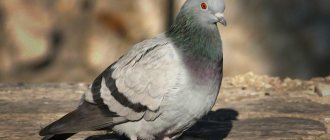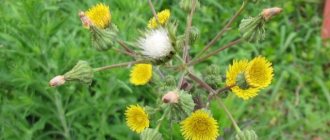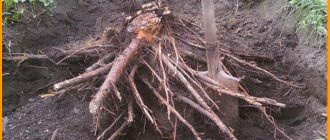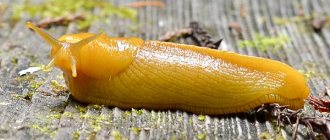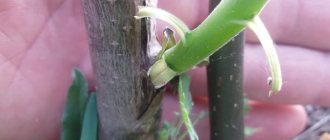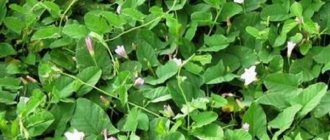Due to their rapid growth and, as a consequence, difficult eradication, some plants, for example, are considered weeds. They grow almost everywhere, are capable of producing a large number of seeds and are distinguished by an abundance of buds on the rhizomes, due to which they displace nearby growing cultivated counterparts, causing a strong desire among summer residents to get rid of the dream forever.
Common gooseberry (pictured) is a weed with unique healing properties.
On the other hand, borer, although a weed, is valuable by nature. People have shown attention and interest in it as a source of nutrition with beneficial qualities and healing properties for many centuries. In Russia, the first spring shoots of this plant were often used for food (along with nettle, dandelion, quinoa, etc.), and there was an expression: “If only I could live to sleep.” Nowadays, they are also added to soups, borscht, okroshka, salads and prepared - fermented, salted, pickled and dried.
Therefore, when starting the fight against weeds, you should choose a middle ground, without taking yourself to extremes with a grueling fight against the weed, and, if possible, use its best qualities for the benefit of yourself and your summer cottage.
The decorative form of dream is variegated, used in landscape design and in the design of flower beds
How to identify a snot
The borer belongs to the Umbrella family. The stem of the plant is straight and tubular. The plant reaches an average height of 50-100 centimeters. The leaves are trifoliate, somewhat reminiscent of a goat's hoof. From the description, you won’t immediately understand what the wart looks like, so you can see the wart in photographs.
Sapling has small flowers collected in umbrellas and reminiscent of dill. Flowering of the honeydew begins at the very beginning of summer, June-July. After flowering, small brown fruits are formed.
All the strength of the plant is in the rhizome, since it is very creeping, which is why when gardeners encounter it in the garden they cannot cope with the whining, or it happens that it comes from neighbors, and until they remove it from the site you will still have to fight it . The rhizome can be buried a meter into the ground and fill the entire area, while displacing all cultivated plants, which is why gardeners do not want to see anything useful in it and begin to fight.
The gooseberry multiplies very quickly by self-seeding and can grow throughout the entire area in a short time, so if you leave the area unattended for one season with a couple of gore bushes, then next year you may not recognize it.
This perennial is one of the most malicious and annoying; the fact is that such a plant, under favorable conditions, can grow quietly for about 50 years. In addition to the fact that the plant lives for a long time and grows quickly, it also very quickly displaces all useful crops and depletes the soil. Since the rhizome of the plant is powerful, weak plants will suffer first and simply die. In order to destroy all cultivated plants from a plot, two years will be enough for this weed, and this despite the fact that the plot will be large. Since the gooseberry has a powerful rhizome, it accordingly greatly depletes the soil, so even after you get rid of this annoying plant, you will have to restore all the useful substances and its fertility in the soil for a long time, otherwise you won’t be able to grow anything on such land and will have to be content small and rare harvest.
In fact, this is not all the problems that can arise with the appearance of the pineweed, this plant grows tall and has dense foliage, and this is an ideal habitat for many pests and larvae, which are carriers of many diseases for cultivated plants.
Therefore, as soon as you notice that a borer has appeared on your site, immediately begin to act and destroy it.
To ensure that the weed does not appear on your site or as soon as you remove it so that it does not return, there are preventive measures that will help you not encounter this weed.
Clearing the garden of plants
Before destroying the borer, care must be taken to ensure that it does not spread underground. To do this, you will need to fence the area. Slate, which needs to be buried to a depth of 40 centimeters, helps to achieve the desired goal.
To destroy the borer, you need to remove its underground stem. The best option is to use herbicides.
The most effective herbicides against borer:
- Tornado;
- Roundup;
- Killer;
- Sniper;
- Hurricane.
The use of chemicals can adversely affect human and animal health. Therefore, you should work with such products wearing gloves, boots and a respirator.
An effective weed remover is Glyphosad. All of the above herbicides work well against various types of weeds, including weeds. These are pesticides, spraying with which has a negative effect on all plants, including cultivated ones. It is important to remember that plants get used to such liquids very quickly, so they should be changed periodically.
Also a good option for removing weed is the attrition method. To do this, you will need to constantly monitor the young shoots. When the first leaf appears, the plant must be destroyed. You need to cut the seedlings just below the root collar. If you do this correctly and systematically, the plant will not have the strength to develop and will die on its own.
Mature bushes should be removed at soil level. Then water the cut with herbicide. It is recommended to repeat the procedure after 7 days. The first results will be visible within two weeks. This method can also be applied to other types of weed, one of which is burdock.
Based on the options listed above, getting rid of dreaming is not so difficult. Compliance with the rules and sequence of actions will give the desired result. In just a few months, your site will become perfectly clean without losing its fertility.
Digging
It is the simplest method that does not require any additional funds. You just need to periodically carefully dig up the soil; you can do this with an ordinary shovel, and if you have a large area, arm yourself with a cultivator. It would be best, of course, if you dig up the area with a pitchfork; if you are worried about a small amount of weed, then by digging up the soil with a pitchfork you can remove the plant without damaging its roots, but a cultivator or shovel cuts the roots, but later these roots grow again and the problem returns again. The roots that you collect must either be burned or eliminated from the site.
Effective destruction of scum
In order to completely eradicate this weed and clear even the most neglected garden plot of it, you need to strictly follow a very effective, albeit labor-intensive, agrotechnical algorithm proposed by specialist M. Nikiforov.
To begin with, it is recommended to remove the top fertile layer of soil (that is, turf), which, as a rule, contains the remnants of long rhizomes. Next, it should be laid out on a dry, level place, placing the fragments close to each other, and watered with a concentrated solution of urea or saltpeter. In a maximum of a couple of years, all remnants of sprouts, seeds and roots will completely rot, resulting in excellent compost. In the meantime, the noticeable lack of substrate should be made up for with ready-made imported soil. This effective method is called soil improvement.
If the ground has already been dug up several times, it must be tilled annually with a pitchfork, removing weed particles. Sometimes there is a need for manual weeding. In addition, we must not forget about loosening. However, agronomist Nikiforov does not advise summer residents to “fight” the weeds with a shovel.
Of course, in the first years of the fight it is almost impossible to completely get rid of this garden pest. It is possible that after some time he will make himself known again. Therefore, you should try to weed the beds or flower beds at least once a week, mowing the spaces between them using an ordinary scythe or a sickle.
Substitution
Experienced gardeners use this method, as it does not pose any threat to the soil. Having noticed a large amount of weed on your site, in order to remove it you need to plant a replacement crop on the site, it can be row-crop potatoes, or special phytophages that feed on weeds, thereby helping to get rid of them. Of course, this method does not imply 100% removal of weeds, but with its help you can significantly reduce the appearance of this weed, and then continue to fight with other known methods.
Useful properties of dream
Dwarf actually has beneficial and nutritional properties. These qualities are primarily due to the chemical composition:
- proteins, carbohydrates;
- carotene, phytoncides;
- ascorbic, malic, citric acids;
- saponins, coumarins;
- essential oils;
- iron, copper, calcium, cobalt, potassium, manganese.
A large amount of vitamin C is found in green leaves and trunk, which helps cope with vitamin deficiency. Due to biological substances, weeds are actively used in folk medicine. Products are prepared that are characterized by the following properties:
- painkillers;
- antifungal;
- choleretic;
- diuretic;
- anti-inflammatory;
- wound healing, sedative effect.
Dryweed and medicines from it help get rid of arthrosis, gout, kidney disease, and rheumatism. Cosmetologists use the weed to make anti-aging masks, face creams, and hair rinses. Alcohol infusions from nymph help treat pathological ailments of the gastrointestinal tract.
Young petioles and leaves are eaten. Fresh salads, soups, and side dishes are prepared from them. The herb has a spicy taste and unusual aroma. Often the mushrooms are dried and pickled.
Attention! Before using folk remedies, you should consult your doctor.
Soil alkalization
The moth prefers to grow in acidic soils, so it is logical not to provide it with these conditions and to alkalize the soil as a preventive measure. To do this, just take chalk or dolomite flour.
The most important thing when carrying out preventive measures is to stop the reproduction of the worm and begin to fight the one that remains, because if the worm continues to multiply, then there is little point in this, such a fight can drag on for a long time and will require a lot of effort, time and money.
Description of the plant
Dryweed is a perennial plant of the Apiaceae family. Reaches a height of up to 1 m. Stems are straight, hollow. The upper part is decorated with umbrella-inflorescences. Each consists of 10-20 rays. On one inflorescence, 30 white flowers immediately bloom. The grass is a honey plant. The photo shows that the leaves of the weed are large, green, and numerous. The length of the leaf plate is 20 cm. The root system goes into the ground to a depth of 40 cm. The main part is creeping.
Fruiting is possible only at the main, upper umbrella. The rest are infertile. After flowering, a seed capsule is formed. The fruit size is 4 mm. The seeds are heavy and are not carried by the wind. Flowering duration is 30 days, from May to June. Propagated by seed, vegetative means, division of rhizomes.
The weed is incredibly tenacious, frost-resistant, perennial. It takes root and develops well in moist areas. Does not have a specific rest period. The gooseberry is able to overwinter with green foliage in the southern regions. It is growing quickly. 2 years are enough for the entire area to be covered with thickets.
Attention! The life cycle of the moth under favorable conditions is 50 years.
Control measures
Now let's figure out how to get rid of dreams once and for all.
Weeding
The method of getting rid of weeds that we all know is, of course, the most common weeding. If you have a small area at your dacha, then you need to try this method first, but for those who have entire fields it may be difficult, since manual It is simply impossible to remove all the plants. For weeding, gardeners recommend a device such as a flat cutter; it has a long handle, so when you spend a long time in the garden and weeding, your back will not get as tired as if you were bending down to remove weeds.
Exhaustion
The method is also very simple and is perfect for owners of small plots, all you need to do is mow the grass almost to the root every time it starts to grow, of course, this procedure will need to be carried out several times, but each time the grass will begin to grow slower and slower , and soon it will completely stop appearing on your site.
Mulching
This is one of the best methods that will not cause any harm to your plants. In fact, mulching has many different advantages, so it will not only help get rid of all weeds, but also helps the soil retain moisture, improves the metabolic process, protects the root system from temperature changes, protects against pests, etc.
The mulch can be a variety of materials, most often it is some kind of black film, but it can also be organic mulch, for example, straw, leaves, sawdust.
Although the moth is a weed, it also needs some conditions for survival, and one of the conditions is light, so if you deprive the moth of light, it will simply die. This method is suitable for controlling any weed, even the most tenacious, since not a single plant can do without light. For the plants to begin to die and the sprouts to stop appearing, 15 days will be enough.
Removing weeds in the garden
Before you begin to fight weeds in your summer cottage, you should remember that the roots of this plant penetrate to a depth of 40 centimeters and can manifest themselves even after some time. Therefore, in order to forget about such a weed once and for all, you need to make every effort.
Before removing the tree from the garden, you should remember that it does not tolerate being in the vicinity of Jerusalem artichoke.
Tilling the garden with a pitchfork
This is the most primitive but effective method. Thanks to the long “fingers” of the fork, it is much easier to hook the lower roots of the weed and lift them up.
Weeding
Many summer residents, in order to remove the sap, plant their garden with potatoes. This is a crop that needs frequent weeding and hilling. Such procedures are beneficial for potatoes, but destructive for weeds. The more often you weed your garden, the faster this annoying grass will “go away” from your plot.
Use of polyethylene
This method is used only in spring. To do this, you need to dig up the area where the gooseberry grows. Then carefully cover the soil with dark polyethylene. The garden should be in this state until the seedlings or seeds are planted. But the film doesn’t have to be removed. In this case, you will need to make small holes in the canvas into which the plants will be planted. This method does not require much effort. If everything is done correctly, then it will be possible to overcome whining in just one summer season.
Covering the bed with cardboard and compost
To do this, you will need to trample down the weeds and place sheets of cardboard or other thick paper on top. The next layer should be manure or compost. When the organic mixture is heated to 700 C, most of the grains lose their properties and do not sprout, and the roots will not be able to break through the paper and will go down.
The methods described above for getting rid of dreaming will certainly give the desired result. But if it was not possible to remove this weed from the garden, then you can, as in the previous option, use herbicides.
For those whose summer cottage is covered with carpet, you can use a completely different method. To do this, you will need to turn over the top layer of soil, and water the roots that remain in the soil with urea. Cover the loosened soil with polyethylene. After a month, repeat the procedure. If you do everything correctly, then there will be no trace left of the plant in just two to three months.
Attrition method
This is one of the most effective ways to control rhizomatous weeds. It consists of depleting their roots until they die.
This method is based on the biological characteristics of rhizomatous weeds. When a sprout emerges from an underground bud, it first takes nutrients for its development from the roots. It drains them. When the shoot opens its first leaves, the process of photosynthesis begins. Now, from the above-ground part, nutrients enter the root. It replenishes its reserves, thickens, and then begins to grow. Additional buds appear on it, from which new weeds grow over time.
Given these patterns, seedlings are allowed to grow while they exhaust the rhizomes and then destroyed. This method consists of 2 steps:
- First, dig up the soil to chop the roots into small pieces. Firstly, it activates the buds and provokes the growth of a large number of new shoots at once. Secondly, the remaining rhizomes are small and depleted faster.
- About 2 weeks after the sprouts appear, they are destroyed. This needs to be done while they are still pale. They should not open their leaves and turn green. Well, it’s not easy to mow them, but also to capture part of the root.
The procedure is repeated 3-4 times. Usually this is enough for the complete death of the rhizomes.
How to protect a site from drift
This issue is acute for those whose dachas are located next to neglected areas. In addition, sometimes you need to protect a patch of land that has been cleared of borer from your own, not yet cultivated, territory.
There is no way to escape from the seeds, but the rhizomes of the rhizome pose a more serious danger. To prevent them from penetrating into clean beds, a trench 30–40 cm deep is dug along their perimeter. Sheets of metal, slate or other durable material are placed in it so that it protrudes 10 cm above the soil level. Then the trench is buried. It is important that there are no holes in this underground wall, since the rhizomes of the rhizome can find even a tiny hole and get through it into the fenced area.
Another important preventive measure is not to put weeds with rhizomes, flowers and seeds in the compost heap. Fresh shoots will appear from the rhizomes, seeds will germinate, and flowers even in uprooted plants can quickly form seeds. It is better to burn these dangerous parts of the weed.
Where does the snot appear on the site?
The moth first appears in areas adjacent to forests and damp, wetlands - it is shade-tolerant and moisture-loving. The seeds of the plant are brought from the wild; the plant itself feels great in the improved garden soil and quite quickly begins a “victorious march”, penetrating into neighboring areas. And the presence of unkempt, or even simply abandoned, pieces of land in a garden community is a real curse for the neighbors, since the people will “come” from there again and again. Dryweed can also enter the site with the soil - it reproduces well from pieces of rhizomes.
Snooping in the summer cottage
It has been noticed that the duck does not like direct sunlight. In direct sun, it loses competition with cultivated plants (for example, lawn grasses) and hardly develops, but in the shade it easily takes over the entire accessible territory, drowning out other plants.
Where does the honeydew grow?
In the plant system, gooseberry is distinguished in the umbrella family (Umbelliferae) by a separate genus - Aegopodium. The most common is the common gooseberry (Aegopodium podagraria L.). Translated from Greek, the Latin name of the plant means “goat’s foot”: its leaf looks like a goat’s hoof.
In Europe and Asia it is difficult to name a country where the squash is not found. It is widespread in almost all regions of Russia and the CIS. Everywhere, the borer forms continuous thickets in clearings, waste areas, and near housing. Occupies significant areas along the edges of deciduous and mixed forests.
Local residents refer to the snot as swamp kupir, deglitsa, snitka, dedilnik and other names. The name of the plant in Russian supposedly comes from the concept of “food”, which confirms the edibility of the wild plant.
